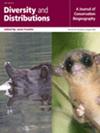Combining Distribution Models of Plants and Their Mutualists to Map Gaps in the Knowledge of Ecological Interactions
Abstract
Aim
The distribution of species relying on mutualistic partners for reproduction can be constrained by their partners' distribution. Nonetheless, biotic interactions are often overlooked when estimating the distributions of species (e.g., pollinators of a given plant and the proportion of them with their distribution modelled). In the Tropics, the abundance of highly specific interactions provides a promising model to test the extent of these limitations, but regional knowledge gaps (e.g., occurrence and biotic interactions) hinder this potential. Here, we combine interaction data with niche models to identify such gaps and recommend targets for natural history studies and future sampling efforts.
Location
Tropical Americas.
Methods
We compiled occurrence records for a dataset of pollination interactions of plants exclusively pollinated by male euglossine bees. We calibrated individually tuned niche models for 37 plants and 39 bee species. We compared the potential distribution overlaps across plants and their respective pollinators and discussed their interpretation in relation to different indicators of knowledge gaps.
Results
Overlap between the potential distribution of plants and their pollinators varied across species and regions. Among the plant species modelled, 62% had insufficient information on their pollinator distribution or identity. The overlapping potential distribution of plant-pollinators was positively related to the proportion of known pollinators included in our models. Plant species more frequently studied were also associated with higher numbers of reported pollinators. Northern South America and the Amazon basin were identified as the major gaps.
Main Conclusions
Despite increasing research effort on this system, significant sampling gaps persist. Considering the high plant richness, a surprisingly low proportion of species (ca. 1.5%) had pollinator identities and distributions sufficiently documented. We provide a framework to identify and map such gaps. Our study evidences the need to improve sampling and digitisation efforts in poorly documented regions and taxa. This can be extended to other systems, improving biodiversity documentation and conservation monitoring.


 求助内容:
求助内容: 应助结果提醒方式:
应助结果提醒方式:


